Up-conversion luminescence and optical thermometry of Yb3+/Tm3+ co-doped AlN nanowires
IF 5.8
2区 材料科学
Q2 CHEMISTRY, PHYSICAL
引用次数: 0
Abstract
Due to its unique advantages including non-contact operation, high sensitivity, and exceptional spatial resolution, nanoscale optical thermometry has become an indispensable technique with widespread applications in micro/nanoelectronics, integrated photonic systems, and biomedical engineering. Here, Yb3+/Tm3+ co-doped AlN nanowires were successfully synthesized via an arc-discharge method. The nanowires, characterized by X-ray diffraction, Raman spectroscopy, X-ray photoelectron spectroscopy, energy-dispersive X-ray spectroscopy, scanning electron microscopy, and transmission electron microscopy, exhibit lengths of several micrometers and uniform diameters ranging from 10 to 20 nm, yielding a high aspect ratio. Under 980 nm excitation, the nanowires display distinct up-conversion (UC) luminescence, with emission bands at 544 nm (green), 654 nm and 691 nm (red), and 795 nm (near-infrared), corresponding to Tm3+ ion transitions. The AlN:Yb3+/Tm3+ nanowires show excellent optical thermometry performance, achieving a maximum relative sensitivity (Sr) of 3.32% K-1 at 298 K and a temperature resolution (δT) of 0.009 K. These results underscore the potential of AlN:Yb3+/Tm3+ nanowires for advanced optical temperature sensing in nanotechnology, biomedical applications, and high-resolution thermal imaging.Yb3+/Tm3+共掺杂AlN纳米线的上转换发光和光学测温
纳米尺度光学测温技术以其非接触式操作、高灵敏度和极高的空间分辨率等独特优势,在微纳电子学、集成光子系统和生物医学工程等领域有着广泛的应用。本文采用电弧放电法制备了Yb3+/Tm3+共掺杂AlN纳米线。通过x射线衍射、拉曼光谱、x射线光电子能谱、能量色散x射线能谱、扫描电子显微镜和透射电子显微镜对纳米线进行表征,发现纳米线的长度为几微米,直径均匀在10到20纳米之间,具有很高的纵横比。在980 nm激发下,纳米线显示出明显的上转换(UC)发光,发射波段分别为544 nm(绿色)、654nm、691 nm(红色)和795 nm(近红外),对应于Tm3+离子跃迁。AlN:Yb3+/Tm3+纳米线具有优异的光学测温性能,在298 K时的最大相对灵敏度(Sr)为3.32% K-1,温度分辨率(δT)为0.009 K。这些结果强调了AlN:Yb3+/Tm3+纳米线在纳米技术、生物医学应用和高分辨率热成像领域的先进光学温度传感潜力。
本文章由计算机程序翻译,如有差异,请以英文原文为准。
求助全文
约1分钟内获得全文
求助全文
来源期刊

Journal of Alloys and Compounds
工程技术-材料科学:综合
CiteScore
11.10
自引率
14.50%
发文量
5146
审稿时长
67 days
期刊介绍:
The Journal of Alloys and Compounds is intended to serve as an international medium for the publication of work on solid materials comprising compounds as well as alloys. Its great strength lies in the diversity of discipline which it encompasses, drawing together results from materials science, solid-state chemistry and physics.
 求助内容:
求助内容: 应助结果提醒方式:
应助结果提醒方式:


